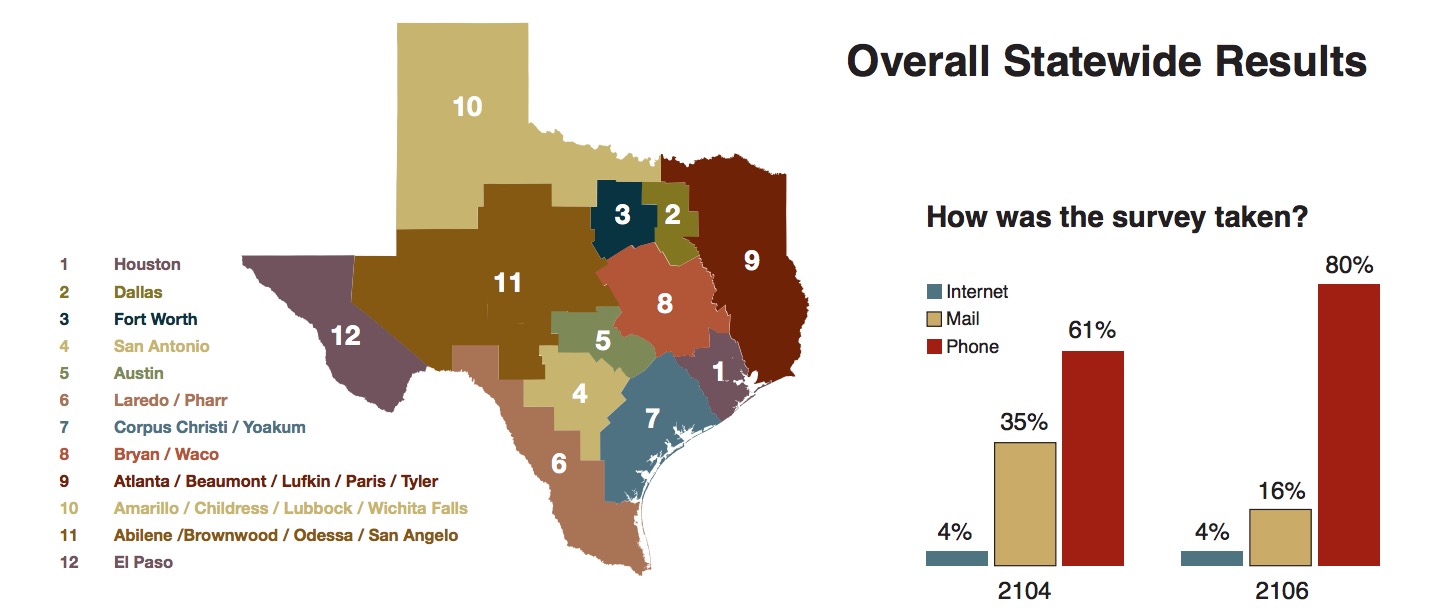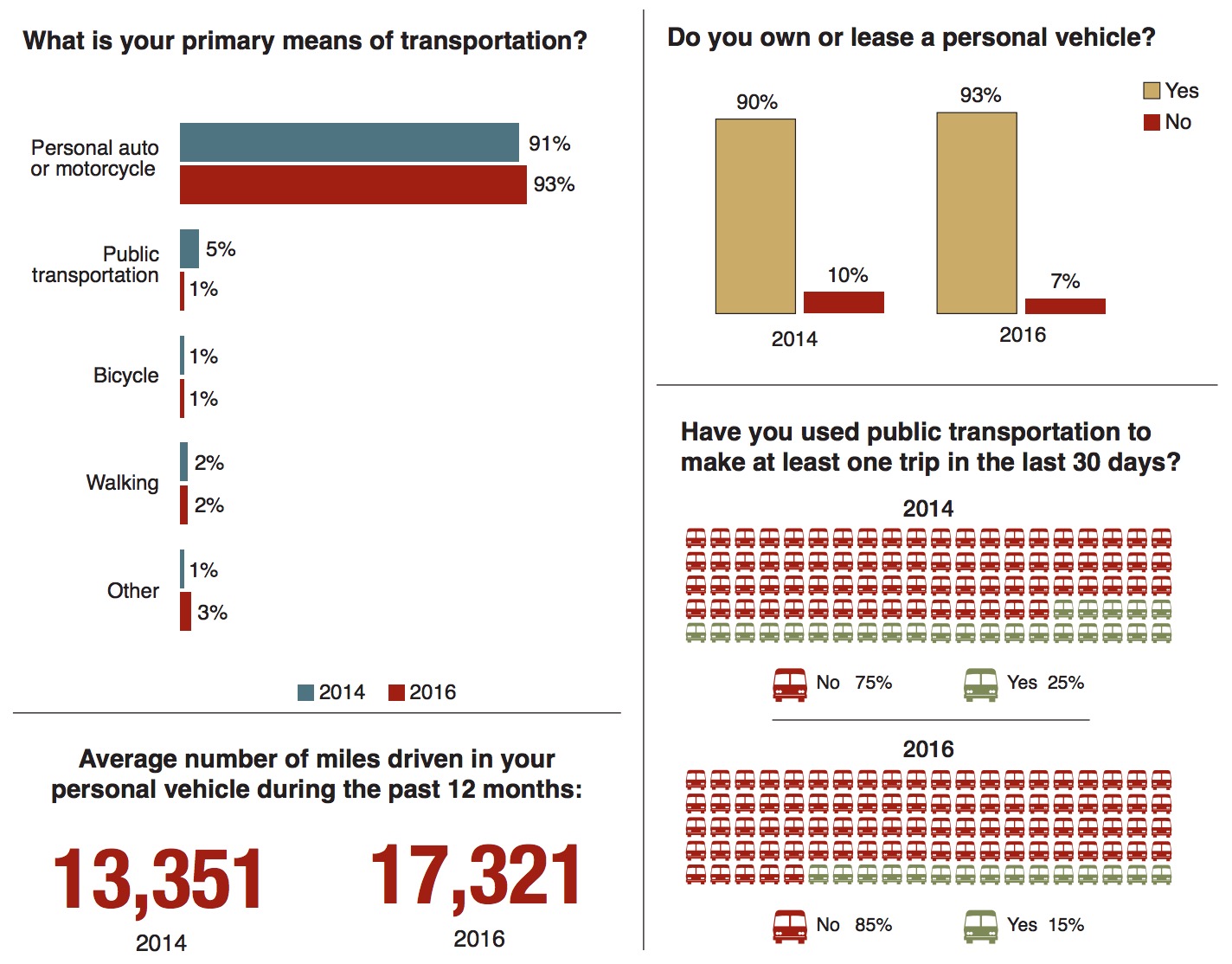TEXAS A&M TRANSPORTATION INSTITUTE
Executive Summary
In spring 2016, the Texas A&M Transportation Institute initiated the second Texas Transportation Poll, a survey of more than 4,000 Texans that assesses public opinion surrounding the following transportation issues:
- Travel behavior.
- Travel solutions.
- Transportation funding.
- Customer satisfaction with governmental agencies.
The biennial survey allows researchers to track changes in public perceptions over time and to give lawmakers a longitudinal view of public sentiment regarding transportation and mobility in Texas. This executive summary presents a top-level synopsis of the survey findings compared to 2014.
Travel Behavior
How Do Texans Travel?
Just as in most other states, an overwhelming majority of Texans use their personal auto as a primary means of travel. This fact, along with much lower 2016 fuel prices, may be contributing to some noticeable differences between the 2014 and 2016 datasets.
How Much Are Texans Using Alternative Modes of Travel?
From 2014 to 2016, the data suggest a greater than 50 percent reduction in the proportion of Texans that are making an effort to drive less because of fuel prices. This sentiment is reflected in the modest increases in both personal vehicle ownership and miles traveled over the two-year period. Therefore, it may come as no surprise that the proportion of Texans using public transit and bicycles to make non-recreational trips has dropped significantly, although more than one in ten Texans reported using at least two alternate modes of travel in the 30 days prior to the survey to make a non-recreational trip. The data suggest that younger Texans are more likely to be found in this group than older Texans, and a majority of Texans believe that public transportation is effective in reducing congestion.
What Are the Perceptions and Reactions to Congestion?
While the proportion of Texans dealing with congestion on a daily basis has remained steady from 2014 to 2016 (76 percent), the perceived severity of congestion has increased modestly. The data suggest that Texans firmly believe the increase in congestion is due to the state’s strong economy drawing people to the state, resulting in an increased demand on existing transportation infrastructure.
In response to this phenomenon, an increased proportion of Texans are implementing specific changes to their daily lives, such as considering congestion in work schedule modifications (telecommuting and/or changing work hours) and making different residential location choices. Interestingly, despite an increase in the proportion of Texans that perceive alternative modes as effective in reducing congestion (a sentiment that is most prevalent in younger and lower-income populations), the actual use of alternative modes, including carpooling, instead of driving has decreased in popularity since 2014. These trends may correlate with declining fuel prices.
To combat worsening congestion, Texans may be relying more heavily on technology-based solutions, such as smartphone apps. In fact, the 2016 poll results show double-digit increases in the proportion of Texans that use a smartphone app (a 19 percentage point increase) or visit a website (a 23 percentage point increase) to help inform travel decisions. Conversely, the proportion of Texans relying on traditional media sources such as radio and/or television has remained relatively stable or fallen.
How Do Texans Feel about Ride Sourcing and Car Sharing?
Given the rise in popularity and use of the sharing economy, several new questions were added to the 2016 poll regarding the use of ride sourcing and car sharing. The data suggest that 7 percent of Texans have used a car share service (such as Zipcar or Car2Go), while 22 percent of Texans have used a transportation network company (TNC) (such as Uber or Lyft). Several demographic factors were associated with the use of either service, with the two factors common to both user groups being age and geography. Car sharing or ride sourcing decreases as users get older and live in more rural areas. With regard to TNCs specifically, Texans were most agreeable that both TNCs and taxis should be regulated at a statewide level and in a similar fashion, creating a regulatory even playing field that does not allow TNCs to operate at a local government level or under less regulation than taxis.
Travel Solutions
What Strategies Do Texans Believe Will Most Effectively Help Reduce Congestion?
Texans still believe that more effective timing of traffic signals is the best of all transportation management strategies offered. However, in 2016 Texans are more supportive of adding lanes to state-maintained roads than better incident management, with non-white minorities more supportive than whites.
Who Should Have to Most Influence on Transportation Policy?
From 2014 to 2016, Texans’ perceptions of who they want to influence transportation policy has remained relatively stable, with auto drivers and state departments of transportation retaining the most influential positions.
Both personal-auto-reliant and non-personal-auto-reliant Texans now agree that auto drivers should have the most influence on transportation policy.
Download full version (PDF): 2016 Texas Transportation Poll
About the Texas A&M Transportation Institute
tti.tamu.edu
Texas A&M Transportation Institute (TTI) develops solutions to the problems and challenges facing all modes of transportation. The Institute conducts over 600 research projects annually with over 200 sponsors at all levels of government and the private sector. In the laboratory and the classroom,TTI researchers help prepare students for transportation careers.
Tags: Poll, survey, Texas, Texas A&M Transportation Institute, Texas A&M University, TX








 RSS Feed
RSS Feed